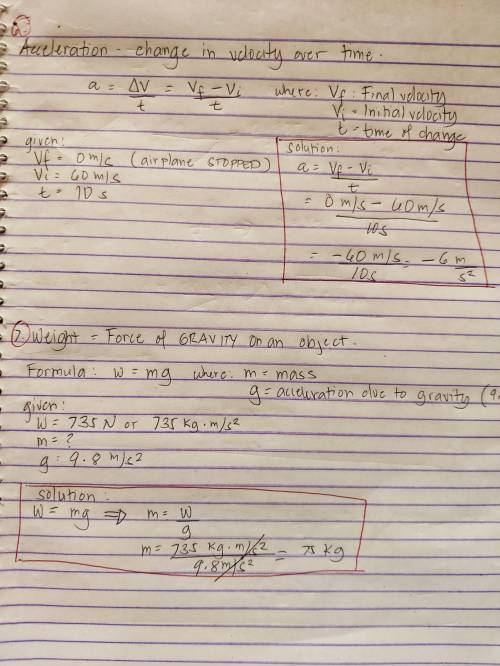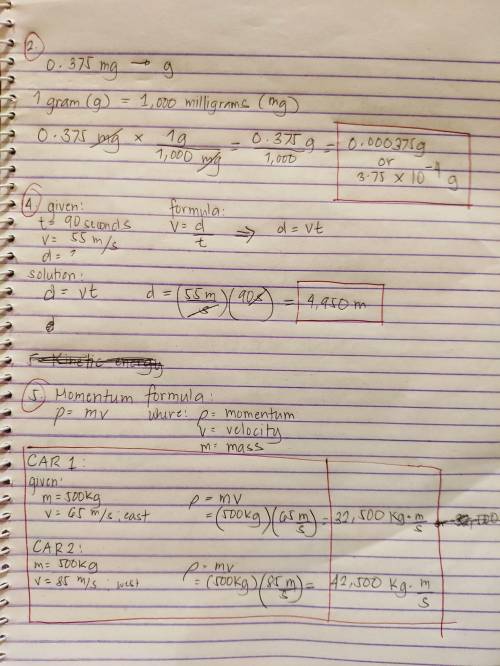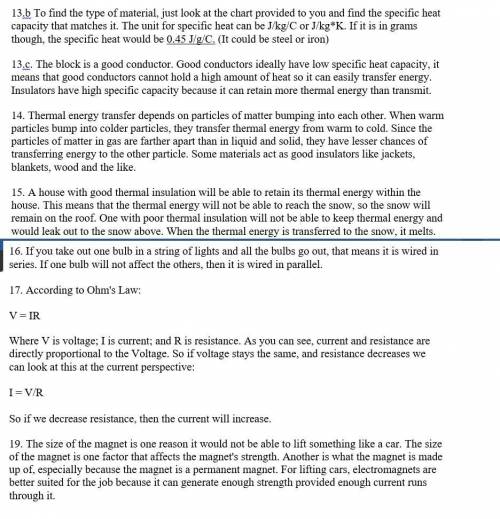
Physics, 22.06.2019 04:00 scbmaster351
1. a student believes that colder water makes fish swim faster. he sets up an experiment using different temperatures of water and measures the speed of the fish. (chapter 1 – page 9) a. what is the independent variable? b. what is the dependent variable? c. list two constants the student should have for this experiment. 2. convert 0.375 mg to grams. show your work with units in order to receive credit. (chapter 1 – page 16) 3. a race car drives one lap around a race track that is 500 meters in length. (chapter 2 – pages 45-46) a. what is the driver’s displacement at the end of the lap? b. how is his displacement different from the distance traveled? 4. how far does a car travel in 90 seconds if it is traveling at a speed of 55 m/s? show the appropriate equation from your textbook and show your work with units in order to receive credit. (chapter 2 – pages 46-47) 5. two cars, both with a mass of 500 kg, are traveling down a road. the first car has a velocity of 65 m/s east and the second car has a velocity of 85 m/s west. (chapter 2 – pages 54-55) a. calculate the momentum of both cars showing the appropriate equation from your textbook and your work with units in order to receive credit. b. which car has the larger momentum? explain how you know. 6. an airplane traveling at 60 m/s comes to a stop in 10 seconds. calculate the airplane’s acceleration. show the appropriate formula and show your work with units in order to receive credit. (chapter 2 – pages 57-58) 7. an individual has a weight of 735 newtons. what is the individual’s mass? show the appropriate equation from your book and show your work with the units in order to receive credit. (chapter 3 – pages 78-79) 8. in terms of newton’s first law of motion, explain why it is important to wear a seatbelt while riding in a car. (chapter 3 – page 86) 9. if you kick a tennis ball with 50 n of force and then kick a soccer ball with 50 n of force, explain the difference in their motion according to newton’s second law. (chapter 3 – pages 81-82) 10. describe how the velocity and acceleration of a skydiver changes as she falls from the plane back to the ground. (chapter 3 – pages 88-89) 11. a child is swinging on swing. describe what happens to both the kinetic energy and potential energy of the child as she swings up and down. (chapter 4 – pages 123) 12. driving to work one morning, you get a flat tire. when using the car jack, you apply 120 n of force to the jack and the jack in turn applies 2000 n of force to lift the car up. what is the mechanical advantage of the jack? (chapter 4 – page 111) 13. a temperature of a 50 kg block increases by 15°c when 337,500 j of thermal energy are added to the block. (chapter 5 – pages 141-142) a. what is the specific heat of the object? show the appropriate equation from your book and show your work with units. b. what is the block made of? use the chart on page 141. c. is this block a good material for insulators or conductors? 14. explain why gases make better thermal insulators than solids or liquids. give one example from the textbook of a thermal insulator that can keep you warm on a cold day. (chapter 5 – pages 147) 15. several days after a snowfall, the roofs of some homes on your street have almost no snow on them, while the roofs on other homes are still snow covered. assuming they have all received the same amount of sunlight, give one reason for this observation related to thermal energy and insulation. 16. if you purchased a string of lights, how could you determine if the lights were wired in series or parallel? (chapter 6 – pages 185-186) 17. what happens to the current in a device if the resistance is decreased but the voltage stays the same? (chapter 6 – pages 181-182) 18. you measure the voltage difference of a circuit to be 15 v and the resistance to be 675 ω. what is the current in the circuit? show the appropriate equation from your book and show your work with units. (chapter 6 – page 182) 19. explain why a magnet from your refrigerator could not be used to lift something as heavy as a car. (chapter 7 – pages 202-203)

Answers: 3


Another question on Physics

Physics, 21.06.2019 20:00
Alice added sodium chloride to water and stirred the water for several minutes. alice is most likely trying to demonstrate that ionic compounds a. are hard. b. can dissolve. c. are clear. d. can melt.
Answers: 1

Physics, 21.06.2019 21:00
A150 w lamp emits light of wavelength 590 nm uniformly in all directions. what is the photon flux (photons per unit area per unit time) on a small screen at a distance 2.3 m from the lamp? assume the photons are uniformly distributed over the surface of a sphere of radius 2.3 m.
Answers: 2

Physics, 21.06.2019 23:30
Which lists the main components of darwin’s theory of evolution? a. random mutations drive evolution; the evolution of a population happens slowly; organisms have common ancestors; organisms do not change. b. natural selection drives evolution; the evolution of a population happens slowly; organisms have common ancestors; organisms change over time. c. natural selection drives evolution; the evolution of a population happens rapidly; organisms have common ancestors; organisms change over time. d. random mutations drive evolution; the evolution of a population happens rapidly; organisms have common ancestors; organisms do not change.
Answers: 1

Physics, 22.06.2019 00:20
Consider the particle-in-a-box problem in 1d. a particle with mass m is confined to move freely between two hard walls situated at x = 0 and x = l. the potential energy function is given as (a) describe the boundary conditions that must be satisfied by the wavefunctions ψ(x) (such as energy eigenfunctions). (b) solve the schr¨odinger’s equation and by using the boundary conditions of part (a) find all energy eigenfunctions, ψn(x), and the corresponding energies, en. (c) what are the allowed values of the quantum number n above? how did you decide on that? (d) what is the de broglie wavelength for the ground state? (e) sketch a plot of the lowest 3 levels’ wavefunctions (ψn(x) vs x). don’t forget to mark the positions of the walls on the graphs. (f) in a transition between the energy levels above, which transition produces the longest wavelength λ for the emitted photon? what is the corresponding wavele
Answers: 1
You know the right answer?
1. a student believes that colder water makes fish swim faster. he sets up an experiment using diffe...
Questions

Computers and Technology, 09.10.2019 18:30








Mathematics, 09.10.2019 18:30

Social Studies, 09.10.2019 18:30




Business, 09.10.2019 18:30





Mathematics, 09.10.2019 18:30








